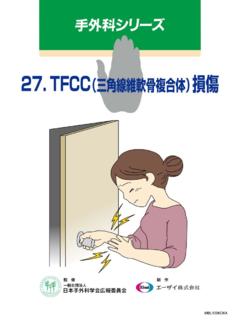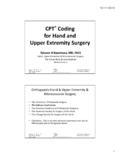Transcription of The Painful Wrist in the Pediatric Athlete - fmed.edu.uy
1 ORIGINAL ARTICLE. The Painful Wrist in the Pediatric Athlete Roger Cornwall, MD. 10 years. Most fractures occur in the waist or distal pole. Abstract: Wrist pain is common among Pediatric and adolescent Scaphoid fractures can occur with ipsilateral distal radius athletes , either as a result of acute injury or chronic stress. fractures. Referring and treating physicians must be aware of occult bony Snuffbox tenderness and tenderness at the distal and ligamentous injuries about the Wrist in order to properly pole of the scaphoid with volar palpation and pain with evaluate and treat acute injuries. The clinician must also be radial deviation of the Wrist or axial loading of the thumb aware of the consequences of repetitive loading of the Wrist are physical examination findings suggestive of scaphoid during upper extremity weight-bearing, especially with regard fractures and should be assessed in any injured Wrist .
2 To distal radius physeal injury in skeletally immature gymnasts. Radiographs should include not only standard PA and The present review provides current strategies for evaluation lateral views but also a posteroanterior view in ulnar and treatment of several less commonly discussed sources of deviation. However, nondisplaced fractures may be un- Wrist pain in the Pediatric Athlete , including scaphoid fractures, detectable on plain radiographs. Magnetic resonance scapholunate ligament injuries, triangular fibrocartilage injuries, imaging (MRI) is both sensitive and specific for scaphoid dorsal carpal impingement, and gymnast Wrist . fractures in children and can be used after injury, if a Key Words: Wrist pain, Pediatric sports, Pediatric Athlete scaphoid fracture is suspected clinically but radiographs are normal.
3 If MRI is not readily available, follow-up (J Pediatr Orthop 2010;30:S13 S16) radiographs 2 weeks after the injury can aid in the diag- nosis with presumptive immobilization treatment until final diagnosis, although occult scaphoid fractures in adolescents can take up to 7 weeks to become evident on BACKGROUND plain If a fracture is readily apparent on plain radiographs, but displacement is unclear, computed Sports are a major cause of hand and Wrist injury in tomography (CT) is helpful for assessing the degree of children and ,2 The Wrist and hand are the displacement in the sagittal plane. leading sites of injuries in many sports,3 including sports Most scaphoid fractures are nondisplaced and that do not use the hands, such as soccer,4 skateboard- can be treated nonoperatively with high rates of union ing,5 and Sports activities can produce after immobilization in a thumb spica Displaced a wide variety of injuries about the growing Wrist , but scaphoid fractures are best treated with open reduction because most epidemiologic studies have focused on and internal fixation with wires or, more commonly, fractures, the true incidence of ligamentous and cartila- osseous screws.
4 On rare occasions, structural bone graft ginous injuries in this population is not known. Chronic is required to anatomically align the scaphoid in acute and overuse injuries can also cause Wrist pain and dys- cases. CT scans are used to determine the degree of function in growing athletes . displacement and operative indications. In adults now, The following sections will discuss acute and chronic percutaneous fixation is commonplace for nondisplaced injuries to the Pediatric Athlete 's Wrist with special atten- or minially displaced acute fractures. The indications tion to diagnoses that may be unfamiliar to the general in adolescents are unclear but are also becoming more Pediatric orthopedist. commonplace practice in the elite Athlete .
5 Under fluoro- scopy, at times with arthroscopic assistance, volar distal ACUTE INJURIES to proximal or dorsal proximal to distal screws are placed. This is particularly useful in proximal pole Scaphoid Fractures fractures that have such a high rate of avascular necrosis The scaphoid is most commonly fractured carpal and nonunion. bone in The peak age for scaphoid fractures As many as two thirds of scaphoid fractures in is 13 to 15 years, and scaphoid fractures are rare under adolescents present as nonunions9 (Fig. 1). Scaphoid nonunions can be treated with open reduction, internal From the Division of Orthopaedic Surgery, Cincinnati Children's fixation, and bone grafting with vascularized bone graft Hospital Medical Center, Cincinnati, OH.
6 Reserved for cases with established avascular necrosis Reprints: Roger Cornwall, MD, Cincinnati Children's Hospital Medical Center, 3333 Burnet Avenue, Orthopaedic Surgery, C3-415, Cincinnati, of the proximal pole or failure of conventional bone OH 45229. E-mail: ,11 Results are excellent for healing, return of Copyright r 2010 by Lippincott Williams & Wilkins function, and motion. J Pediatr Orthop Volume 30, Number 2 Supplement, March 2010 | S13. Cornwall J Pediatr Orthop Volume 30, Number 2 Supplement, March 2010. FIGURE 1. A, Scaphoid waist fracture nonunion in an adolescent football player who sustained a fall on outstretched hand 6 months before presentation. B, Successful union after open reduction, internal fixation, and distal radius bone grafting.
7 Distal Radius Fractures The incidence of distal radius fractures does not necessarily correlate with sports activity likely owing to the extremely common nature of this None- theless, sports activities are a major cause of distal radius fractures, and some of these injuries may be preventable. For instance, Wrist guards lower the risk of distal radius fracture in high-risk sports, such as inline skating13 and The evaluation and treatment of distal radius frac- tures is covered in detail in subsequent sections of this symposium, but it is worth noting in this context potential concomitant injuries more distally in the Wrist , such as scaphoid fracture and triangular fibrocartilage complex (TFCC) tear. Scaphoid fractures should be routinely ruled out by physical examination (and further imaging, if needed) in any distal radius fracture in adolescents (Fig.)
8 2). Tears of the TFCC are likely to be quite common in the setting of a displaced distal radius fracture, especially, when accompanied by a displaced ulnar styloid However, the majority of these tears likely heal uneventfully in the time that it takes the distal radius fracture to heal and are thus not a cause of ongoing pain. Nonetheless, persistent ulnar-sided Wrist pain after success- ful treatment of a distal radius fracture should prompt investigation for unresolved TFCC tear. Artho-MRI scans are the most useful diagnostic test and arthroscopy is the gold standard for diagnosis and treatment. Scapholunate Ligament Injury Ligamentous and cartilaginous injuries may go unrecognized in children and adolescents owing to diffi- culty in evaluating the incompletely ossified carpus and a propensity to assume that Wrist injuries with normal FIGURE 2.
9 Sagittal CT image showing ipsilateral distal radius radiographs are physeal fractures. Scapholunate distance and scaphoid fractures in an adolescent. S14 | r 2010 Lippincott Williams & Wilkins J Pediatr Orthop Volume 30, Number 2 Supplement, March 2010 Wrist Pain in Pediatric athletes and Perilunate dislocation should be treated with reduction, ligament repair, and pinning. TFCC Injuries Injuries to the TFCC are commonly diagnosed in adults but not often considered in children. TFCC injuries can coexist with distal radius fractures in children or can occur as isolated ,20 Ulnar-sided Wrist pain and swelling after a twisting injury to the Wrist (such as in color- guard, stick sports, falls) should raise suspicion for acute TFCC tear. Tenderness palmar to the ulnar styloid and pain with full passive supination are indicative of a TFCC tear.
10 Splinting or casting can be used as initial treat- ment depending on the degree of symptoms. Persistence of symptoms prompts MRI with or without intraarticular contrast, although some tears may be missed with even the most advanced imaging. Arthroscopy can confirm FIGURE 3. Arthroscopic visualization of a large peripheral diagnosis and allow repair of large tears with satisfactory triangular fibrocartilage complex tear after an acute twisting results in children (Fig. 3)20. injury to the forearm. CHRONIC PAIN. on Pediatric Wrist radiographs does not reach the normal adult value of 2 mm until at least age Persistent Wrist Gymnast Wrist pain and appropriate clinical examination findings should Wrist pain is common among growing gymnasts, raise suspicion for scapholunate injury even with normal including elite and nonelite competitors, which can be radiographs.





